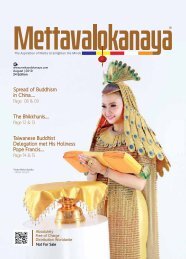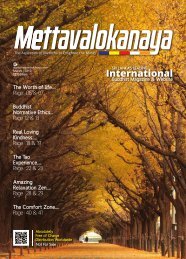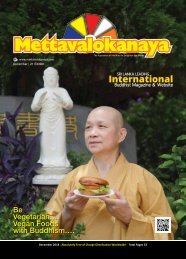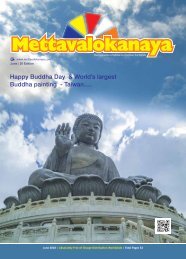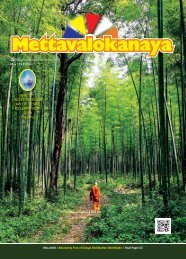#Mettavalokanaya_International_Buddhist_Magazine_May_2021
This is the World’s Most Popular & Leading Monthly International Buddhist Magazine, “Mettavalokanaya” on May 2021 Vesak Edition - 31. https://mettavalokanaya.com/magazine-31/ http://www.mettavalokanaya.com/
This is the World’s Most Popular & Leading Monthly International Buddhist Magazine, “Mettavalokanaya” on May 2021 Vesak Edition - 31.
https://mettavalokanaya.com/magazine-31/
http://www.mettavalokanaya.com/
Create successful ePaper yourself
Turn your PDF publications into a flip-book with our unique Google optimized e-Paper software.
The name of Danzanravjaa
has a profound connection
with many branches of
Mongolian culture. He was an
extraordinary polymath, a poet and
Buddhist lama, he was a philosopher
and the creator of nomadic theater,
he was a choreographer, lyricist
and composer, a Buddhist scholar,
an environmentalist and a traveler.
Danzanravjaa was born in 1803 into
the poor family in what is today
Shuvuun Shand, near to Dulaanhar
Hill in Dorngovi aimag. In his brief
biography, his father, Dulduit, wrote
that when the child was born his
body emitted light. Danzanravjaa’s
mother died when he was a child,
and as he wandered around with
his father, his genius began to show
itself. When he was five years old, as
his father was performing a ritual to
bring good fortune to a local family,
a severe rainstorm suddenly arose.
Droplets leaked through the thin
summer covering of the ger, but when
they didn’t leak onto the child and his
father where they sat next to the door
beneath this hole-strewn roof, the
people laughed at them, and the boy
recited in a lively voice, “When clouds
come and rain falls, what difference is
there between the place of honor and
the door? When actions are fulfilled
and death comes, what difference is
there between old and young?”.
Great
Brilliant Poet
Danzanravjaa...
“There are many stars in the sky,
but only one or two have a special
gleam. There are many beings in
the world, but only one or two have
special wisdom. (from “Hormust”).
Everyone was amazed, and from
that time, the child’s extraordinary
talent and ability began to reveal
itself. Atthe age of six, he took the
vows of a monk, and at nine he was
recognised as a the fifth incarnation
of the Noyon Hutagt. Between eleven
and fifteen, he studied Buddhist
philosophy and tantric practise at
Badgarcholin Monastery, in what
is today Inner Mongolia, and great
teachers such as Janjaa Hutagt, Ajaa
Gegeen and Düinhor Pandit gave him
the instructions and empowerments
for secret mantra practises, and so
his magical and spiritual genius
became gradually more and more
open. Although great scholars of
religion study the Dharma for about
ten years and so reach a high level,
Danzanravjaa was amazing in that he
took a short cut and penetrated the
secrets of the Dharma after about five
years. At sixteen he returned to the
place of his birth and, as he perfected
the practise of secret mantra, he began
to build what is now Övörbayasgalant
Hamriin Hiid. Two years later his
father Dulduit died. After this time,
he gave himself to building temples
and monasteries and to magical
practises such as bringing rain and
spreading the Dharma, he wrote
poetry and composed music and
songs, and he choreographed dances,
and so he spread magic and brought
enlightenment to his homeland of
the Govi. Hamriin Hiid at that time
became the center of Buddhist culture
in the Govi. Alongside the many
monastic schools - such as Lamrim,
Demchig, Sutra and Tantra - which
were established there, there was also
a program of education set up for the
general public. The “Children’s School”
taught reading and writing, nature, art
and dance, and boasted an extensive
library. The “Singing School” was the
center for song and drama, while
the “White Temple” was a museum
with rare and extensive holdings.
By establishing all these facilities,
he brought wisdom to the simple
nomadic people of the Govi through
art and culture and knowledge, rather
than by means of insufficient religious
devotion. At that time, the Manchu
government wanted to keep Mongolia
in darkness, and this was a way by
which a struggle of the intellect could
continue to oppose the thinking of
the Chinese rulers.
Although Danzanravjaa
established many monasteries and
temples in his homeland of the Govi,
he spent little time within range
of his own monastery, and traveled
across Mongolia staging musical
dramas such as The Moon Cuckoo,
writing and performing his own
songs, both secular and religious,
bringing rain to drought-ridden
areas, offering medicine and spiritual
comfort to the exhausted and the sick,
researching the landscape - the water,
hills, rocks, grasses and vegetation -
all the while engaged in the writing
of poetry. Danzanravjaa’s nomadic
lifestyle, accompanied by a train of
dozens of camels and attended by
many of his students, was intended
to lead towards enlightenment. His
anti-establishment ideas meant that
he was criticised by many when he
entered their territory, they were
concerned, among other things, that
“he brought with him many young men
and women, he drank alcohol and was
thoroughly disreputable.” In around
1840, when he arrived at Ih Hüree,
which today is the city of Ulaanbaatar,
he wrote in his autobiography about
how he had been turned away on the
banks of the Tuul River.
Danzanravjaa taught in his
school children gifted in the arts, and
in addition to turning out craftspeople
and actors, some of his students
continued their education, and studied
in the religious school. One of these
groups, made up of female artisans,
was headed by Dadishura. They
staged plays, sang songs, and created
the masks for the religious dances
and for the plays, but they also read
stories aloud to people and taught
them to read and write, and so built
upon Danzanravjaa’s work. Dadishura
was the most famous of these
female artisans. She was a highly
talented woman who worked with
Danzanravjaa in his work on secret
mantra and who wrote music and
directed plays, and she was constantly
by his side. There were many who
misunderstood their relationship, and
thought Dadishura his wife, or else his
secret lover. Danzanravjaa dedicated
many songs to Dadishura, honoring
her as his closest student and his
artistic muse, and in a mundane sense
this could be called love. Dadishura
was intimately connected to his
Dr. G. Mend Ooyo
Poet, Writer and President,
Mongolian Academy of Culture
and Poetry, Founder and Editor
in chief of GUNU Magazine,
Mongolia
life and his art, and it is she who is
the subject of Danzanravjaa’s song
“Perfect Qualities.”
As a man and as a poet, then,
did Danzanravjaa hold a particularly
deep affection for women? Certainly,
he did, and when he couldn’t enter
Ih Hüree, he taught the Dharma to
many of the faithful in the meadow
at Soilgo on the banks of the Tuul. He
organised a festival and performed
songs and music there, and the story
goes that he let slip the reins of love
for a woman from Hangai named
Baljdumaa. Danzanravjaa dedicated
many beautiful songs to Baljdumaa,
and there exist many stories about
the bond of love between them.
Danzanravjaa changed the disdainful
attitude regarding women, which was
widespread during the Manchu period,
and his three objects of devotion were
the goddess Tara, who is particularly
belovèd of women, the swan, and the
symbol of secret mantra, the scorpion.
Dhamma in
Mantra
48 l Mettavalokanaya l May l 2021 2021 l May l Mettavalokanaya l 49











